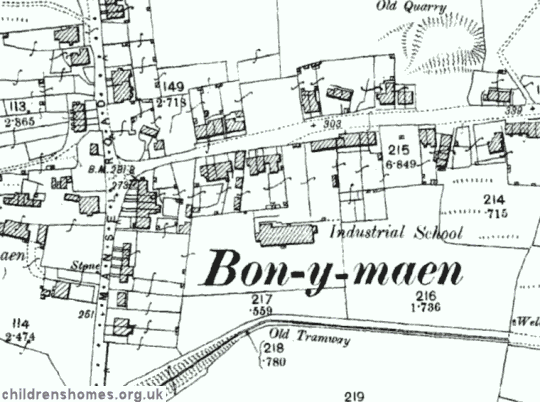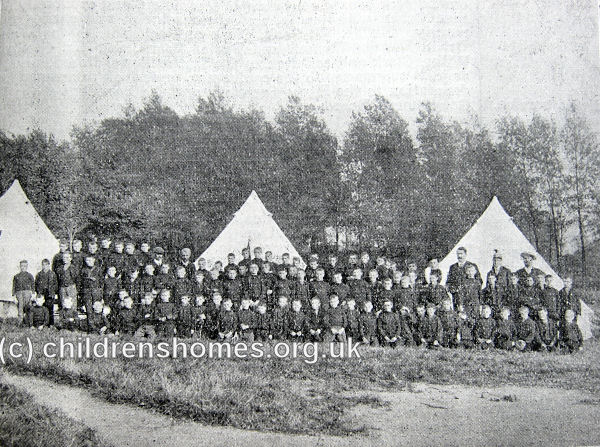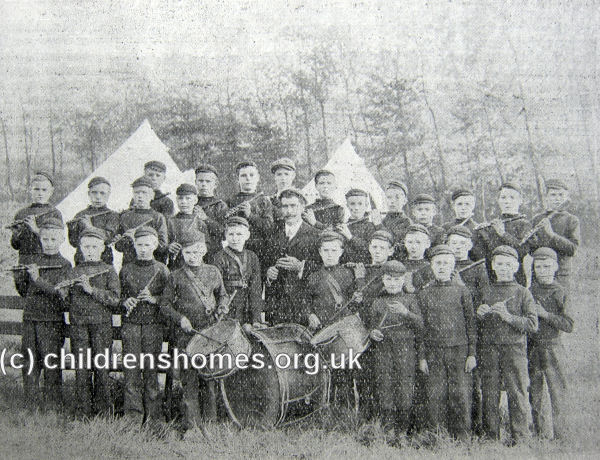Swansea Truant / Industrial School for Boys, Swansea, Glamorgan
In 1882, the Swansea School Board opened a Truant Industrial School in purpose-built premises at Cefn Road, Bonymaen, a few miles from Swansea and overlooking Swansea Bay. The establishment housed incorrigible truants who were subjected to a strict regime before being released on licence. Subsequent truancy from normal schools would result in re-admission to the Truant School for a longer period, coupled with corporal punishment. The buildings were formally certified to begin operation on October 6th, 1882, with accommodation for 40 boys. A total of 23 boys had been received by 31st December of that year. The staff initially comprised the superintendent and matron, Mr and Mrs S.J. Edwards; a labour master, and one female assistant. A schoolmaster, Mr Ward, was appointed in 1883.
An inspection in 1884 noted that on first admission, the boys were placed for four days in separate cells, coming out for school and drill; on second admission the confinement lasted for 10 days, and on a third admission for a month. In cases of re-admission, when it was proved to be the fault of the boy (and not of the parents, as was often the case) the boy was flogged. The boys' classroom performance was said to be satisfactory, given the circumstances of their being in the School. Industrial occupation consisted of housework, a little gardening, and wood-chopping. The inspector remarked that the Visiting Committee had attended very seldom and very irregularly, apparently taking very little interest in the School.
In 1886, it was reported that earth-closets had been installed on the premises. In 1889, the washroom and the laundry were moved into the basement of the building, allowing a separate dining-room to be provided. The system of confinement in cells was abandoned in 1891. In 1893, alterations and extensions were carried out which resulted in the number of places at the School being increased to 80.
The School site is shown on the 1899 map below.

Swansea Industrial School for Boys site, Swansea, c.1899.
The 1896 inspection noted that the School stood in 1½ acres of land, part of which was occupied as a kitchen garden and part as a play-yard, the latter being in need of levelling and asphalting. In the classroom, singing was rated as 'good', while geography, recitation and mental arithmetic were 'fair' or 'very fair'. Drawing and object lessons were 'very fair' throughout. The allocation of boys to industrial occupations was 20 gardening, 20 tailoring, 20 carpentering, 6 sewing and repairing, and 14 working in the kitchen, laundry, or as houseboys. The boys were taught extension motions by an ex-sergeant of the Marine Artillery. The boys could learn to swim in the School's small (15 feet by 9 feet) plunge bath. The doctor visited weekly, examined all new admissions, and made a quarterly report on the health and sanitary condition of the school; at the same time, he also made an individual examination of each boy. The School had an isolated sickroom, but all infections could be treated a the town's fever hospital, boys being carried there by ambulance. It was commented that there was no mark system in operation, nor were there rewards or prizes for good conduct or work. The schoolmaster was now Mr David Edwards, and the labour and drill master, Mr James McCammon.
Every Saturday, all the boys played cricket and football in season in a neighbouring field. During the rest of the week, there was an average of three hours' play on the school premises. Musical drill was carried on daily for half an hour. In 1897, the whole school spent one day at a neighbouring park on the invitation of a friend, and one at the seaside at the expense of the School Board. A science demonstrator from the School Board gave a magic lantern lecture on New Year's day. In July, 1898, the boys had a week's camping on the Downs. The schoolmaster was now Mr H. Jones, with Miss Maggie Thomas as assistant teacher. From January to June, 1900, Mr Jones, was on service in Africa, and his place was taken temporarily by Mr William Beynon. During a further spell of military duty, from September, 1900, to January, 1901, his stand-in was Mr Hedley Perry. Miss Rosamund Leyshon was now assistant teacher.
Beginning in 1900, boys from the school spent several weeks at camp each summer alongside boys from the Swansea Union Cottage Homes.

Swansea boys' camp, 1906. © Peter Higginbotham

Swansea boys' camp band, 1906. © Peter Higginbotham
On August 19th, 1901, the establishment was converted into an 'ordinary' Industrial School, accommodating up to 65 boys who had been sentenced by magistrates to a period of detention. Building works included the building of a gymnasium and reconstruction of the workshops. Also in 1901, one of the boys was 'rushed' from the school by two brothers and three other friends. The boy could not be located but the brothers and one other man were to be prosecuted. A mark system was introduced, with good conduct resulting in monetary rewards every six months.
In February, 1902, Mr William David was appointed as schoolmaster. A drum and fife band was started and by the following year had competed successfully in two Eisteddfodau. It was replaced by a brass band in 1907. In 1906-7, twenty-four football matches were played with the Swansea Schools League, and the School jointly held top place in the competition. Two boys form the School played in inter-town football matches. Six boys obtained the Junior Certificate of the St John Ambulance Association. A fortnight was spent in camp at West Cross. Now steam cooking apparatus was installed in the kitchen, and a sitting-room was made for the servants.
In 1914, after more than thirty years at the School, Mr and Mrs Edwards retired as superintendent and matron, and moved to Australia. Mr William David, schoolmaster since 1902, was appointed as Mr Edwards' successor, with his sister acting as matron.
The closed in March 1922. The premises were later used as a community centre. The buildings no longer survive.
Records
Note: many repositories impose a closure period of up to 100 years for records identifying individuals. Before travelling a long distance, always check that the records you want to consult will be available.
- None identfied at present — any information welcome.
Bibliography
- Higginbotham, Peter Children's Homes: A History of Institutional Care for Britain's Young (2017, Pen & Sword)
- Mahood, Linda Policing Gender, Class and Family: Britain, 1850-1940 (1995, Univeristy of Alberta Press)
- Prahms, Wendy Newcastle Ragged and Industrial School (2006, The History Press)
Links
- None noted at present.
Except where indicated, this page () © Peter Higginbotham. Contents may not be reproduced without permission.


